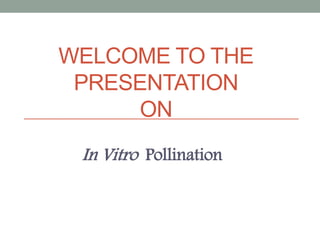In vitro pollination involves pollinating pistils or ovules that have been cultured in a nutrient medium such as Nitsch's medium. This technique can help overcome pre-fertilization barriers to hybridization between plant species. Key steps include sterilizing flower parts, collecting pollen, and applying pollen to excised pistils, ovaries, ovules, or stigmas depending on the method. Factors like culture medium, temperature, genotype, and physiological state of the explant can influence seed set. In vitro pollination has applications in plant breeding like overcoming self-incompatibility or cross-incompatibility barriers and producing haploid plants or hybrids.


![Introduction
‘vitro’ means glass or glassy substances. So, ‘in vitro’
means in glass or glass tube.
Cultivation of plant tissue or other organs on artificial media
in a test tube or conical flask is called in vitro technique.
The process of seed formation following stigmatic
pollination of cultured pistil has been referred to as in vitro
pollination and the development of seed through in vitro
fertilization.
[Ref: MK Rajdan]](https://image.slidesharecdn.com/tissueculture-170204045209/85/In-Vitro-Pollination-3-320.jpg)
![History
• German Botanist Harberlandt (1902) develops the concept of in
vitro culture.
•
• This in vitro pollination technique was developed at university
of Delhi to produce hybrid among species of pavaceraceae and
solanece.
[Ref: Maheshwari and kanta, 1964]
Barriers during pollination and fertilization of in vitro
technique
• Pollination and fertilization under in vitro condition offer an
opportunity for producing hybrid embryos among plants that
can’t be crossed by conventional method of plant breeding.
• In hybridization programs, transferring viable pollen from one
parent to another does not always lead to seed setting.](https://image.slidesharecdn.com/tissueculture-170204045209/85/In-Vitro-Pollination-4-320.jpg)












![Storage condition:
• Usually the first step of this process occurs at room temperature and
without special lighting.
[Zenk teller-1980]
• The ovary cultures are maintained at 22-26 0C and other suitable
conditions favouring embryogenesis.
Genotype:
• The response of in vitro ovaries in relation to the seed set depends on
the species.
• Pollen grains of crucifers are difficult to germinate in culture. Brassica
oleracea ovules in 1% solution of CaCl2 with 10% gelatin and then
pollinated with pollen transferred to Nitsch’s medium until seed set.
• Pollen grains of crucifers are difficult to germinate in cultures and a
modified technique is required to obtain germinable seed.](https://image.slidesharecdn.com/tissueculture-170204045209/85/In-Vitro-Pollination-17-320.jpg)


![Why in vitro pollination is needed?
For the production of homozygous plant.
For the conservation of extinct plant species.
Hybrid production
Reducing the breeding cycle.
Overcome the dormant period.
Production of hybrid species by distant hybridization.
Production of haploid plant.
Conservation of germplasm.
In vitro fertilization using isolated single gamete
A Landmark technique developed recently in the field of plant
biotechnology has been the successful fusion of male and female
gametes isolated from higher plants in vitro and subsequent
regeneration of fusion product into embryo and finally a plant.[Kraz
and Lorz, 1993]. This process is known as in vitro fertilization requires
isolation of male gametes sperms from germinating pollen grainer
tube and of the female gamete (egg) from embryo sac.](https://image.slidesharecdn.com/tissueculture-170204045209/85/In-Vitro-Pollination-20-320.jpg)
![ Fusion of isolated gametes, development of zygote, embryo and
plant take place in the absence of surrounding tissues. Thus in
vitro fertilization using isolated higher plant gametes I different from
that in vivo.
Method:
The methodology of gamete isolation there in vitro fusion, and culture
has been standardized for maize plant. [Kranz, 1999]
Isolation of sperm from pollen grains is executed by osmotic shock in
mannitol solution.
Isolation of ovules is done by micro-dissection of ovule incubated to
40-60 minutes at 24±0.5 0C in enzyme solution set at PH 5.
Microdroplet mannitol solution placed on UV sterilized cover slip with
the aid of micropillaries connected to a computed controlled dispenser
to isolate and select the egg cell.](https://image.slidesharecdn.com/tissueculture-170204045209/85/In-Vitro-Pollination-21-320.jpg)


